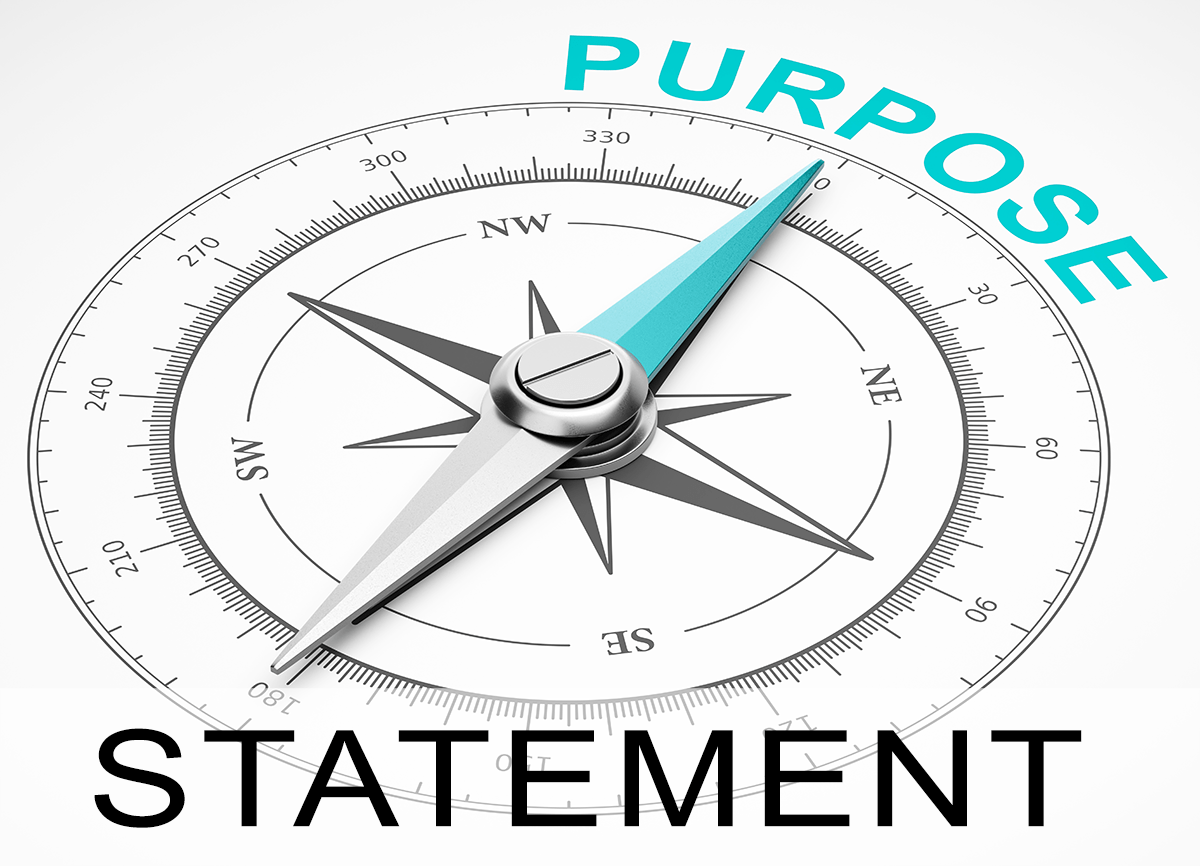Every organization in the world knows “what” they do, most know “how” to do it, but only a few know “why” they do what they do. This “why” isn’t about profit maximization. It’s the reason for the organization’s existence.
See also: Mission Statement
What is a Purpose Statement
A purpose statement is one that clearly explains this “why” and its impact on human, societal, or environmental goals. It addresses the question – “What would the world lose if the company disappeared?” in the most believable, authentic, and inspiring words.
The simplest and most popular definition of a purpose statement is “A higher-order reason for an organization’s existence that goes beyond making money and adds value to society.” [1]
Why having a purpose is important
At its best, a purpose can act as a North Star, a guiding light that allows everyone in the organization from the leadership to the newest employee to understand what they must accomplish and serves as a filter for daily decisions.
In an organization with a well-defined purpose statement, every employee understands the “Why” behind the organization’s existence, defines it in the same way, and more importantly, feels a strong connection to that purpose.
While this might sound theoretical, its real-world implications are profound.
A study by Korn Ferry titled “People on a mission” found that organizations that took the challenging steps of defining their core purpose not only saw strong bottom-line results but also transformed all aspects of their business.
The study revealed such companies posted compounded annual growth rates (CAGR) of 9.85% compared to 2.4% for the whole S&P 500 Consumer Sector [2].
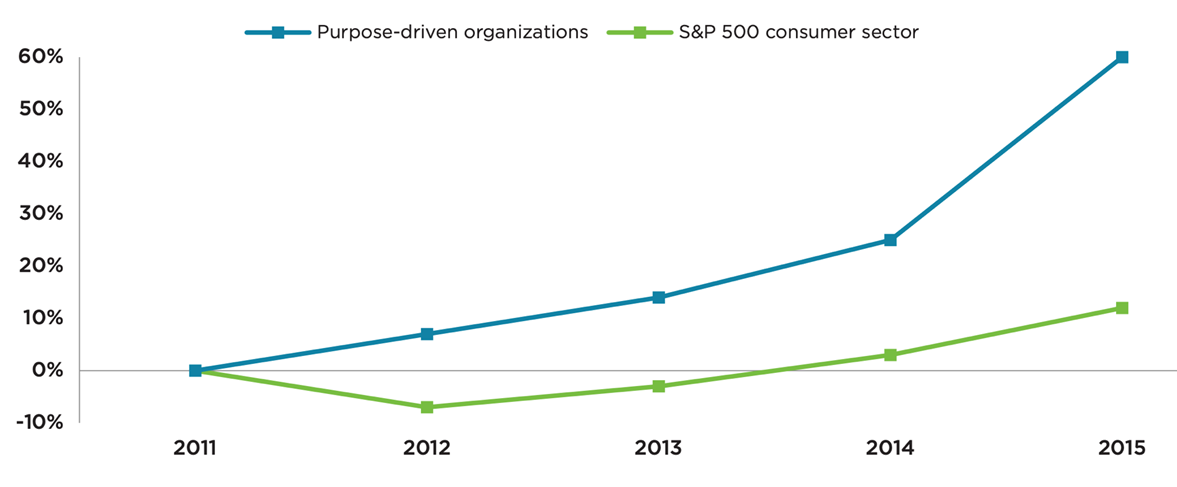
A purpose can also strongly influence an organization’s ability to attract and retain talent and customers. However, it has less effect on suppliers, prices, and other legal aspects:
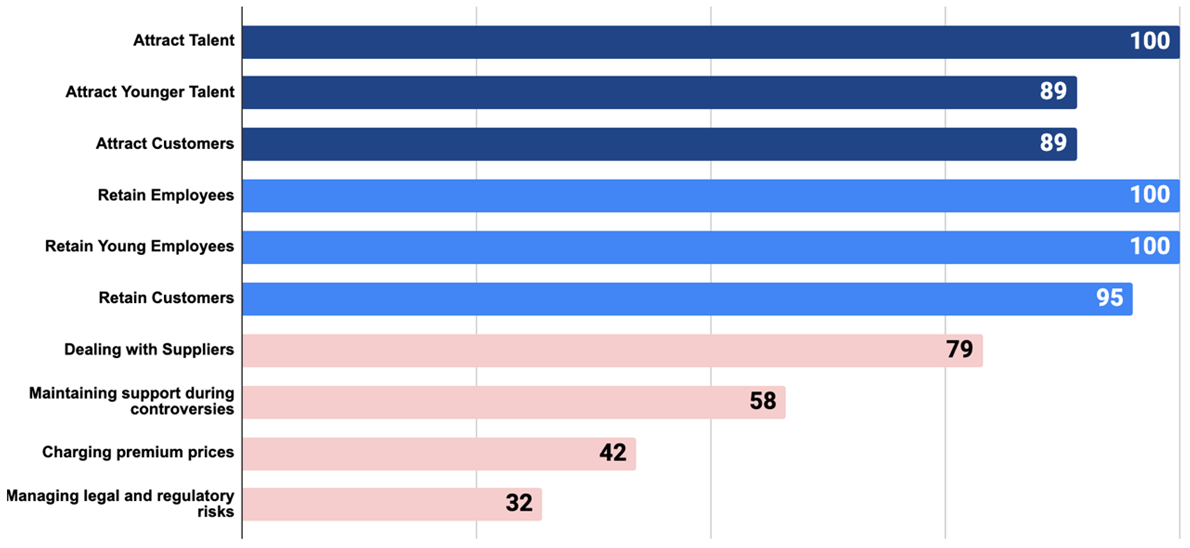
Elon Musk’s companies, Tesla, and SpaceX, though very different in terms of what they do, exemplify the role of a well-defined purpose in shaping success.
As quoted by Mr. Musk, “Putting in long hours for a corporation is hard. Putting in long hours for a cause is easy.” This statement is well supported by the fact that Tesla and SpaceX have consistently ranked among the top choices for engineering talent in the US [3].
Post-pandemic, the significance of a company’s purpose has grown even more pronounced and had a downstream impact on hiring, morale, retention, and performance of employees.
According to a 2021 McKinsey study [4], nearly 70% of employees are reflecting on purpose because of the pandemic. The same study also found that employees who said they live their purpose at work were:
- Six and a half times more likely to report higher resilience.
- Four times more likely to report better health.
- Six times more likely to want to stay at the company.
- One and a half times more likely to go above and beyond for the company’s success.
In another PwC survey [5], 83% of the employees rated “meaning in day-to-day work” as important.
Elements of a good purpose statement
Before we define the elements of a purpose statement, it is important to distinguish between a company’s Purpose, Vision, Mission, Values, and Positioning.
Starting with the Purpose, an organization’s Vision, Mission, Values, and Positioning can be imagined as layers with each influencing the other as shown:
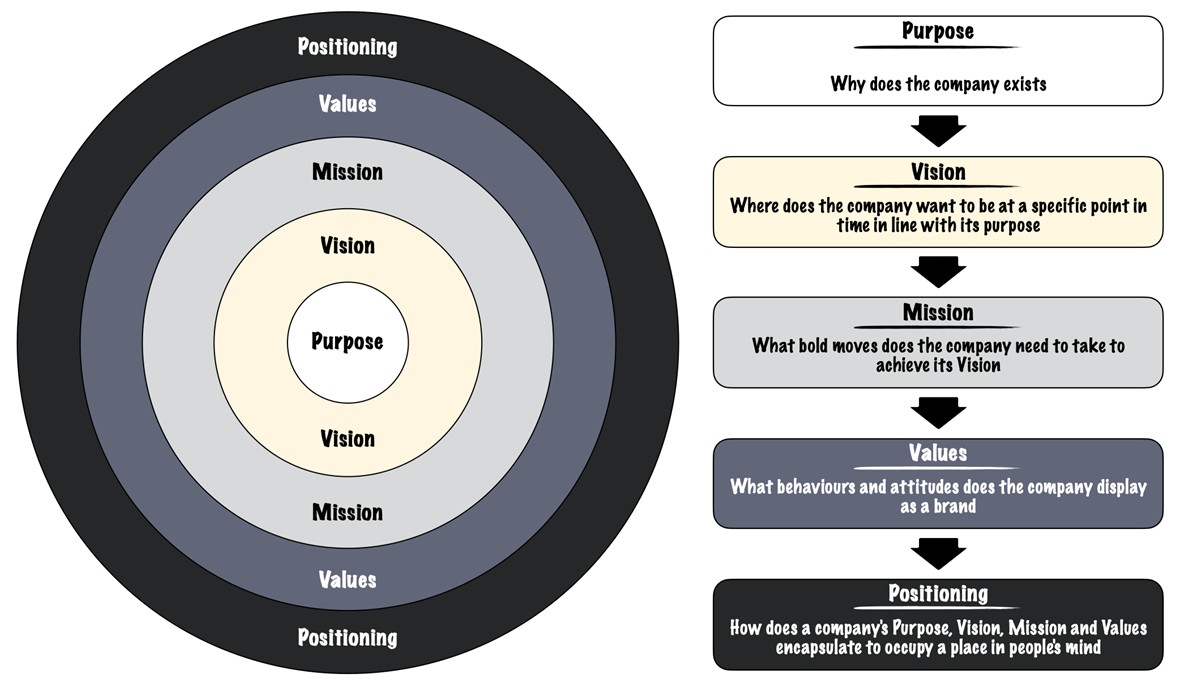
Many organizations use the terms Purpose and Mission interchangeably; However, the purpose defines the “why” while the mission is a big, bold step that is part of the ‘how’.
Purpose statements vary from being vague (e.g., Kroger’s “To feed the human spirit” [6]) to grandiose (e.g., Intel’s “create world-changing technology that improves the life of every person on the planet” [7]) to boring (e.g., Decathlon’s “to be useful for people” [8]).
A well-crafted purpose statement must represent the organization’s aspirations and send clear signals about what the company stands for. Creating one is as much a creative act as a strategic one.
A Harvard study analyzed 66 purpose statements from leading organizations around the world and gathered insights from senior leaders and employees. The learnings were used to develop a diagnostic framework that helps craft the best purpose statement for an organization based on its specific situation [9].
Known as the “SABRE” framework, it is based on five dimensions – four dimensions of content (i.e., what the purpose means) and one dimension of statement formulation (i.e., how the purpose statement itself is worded):
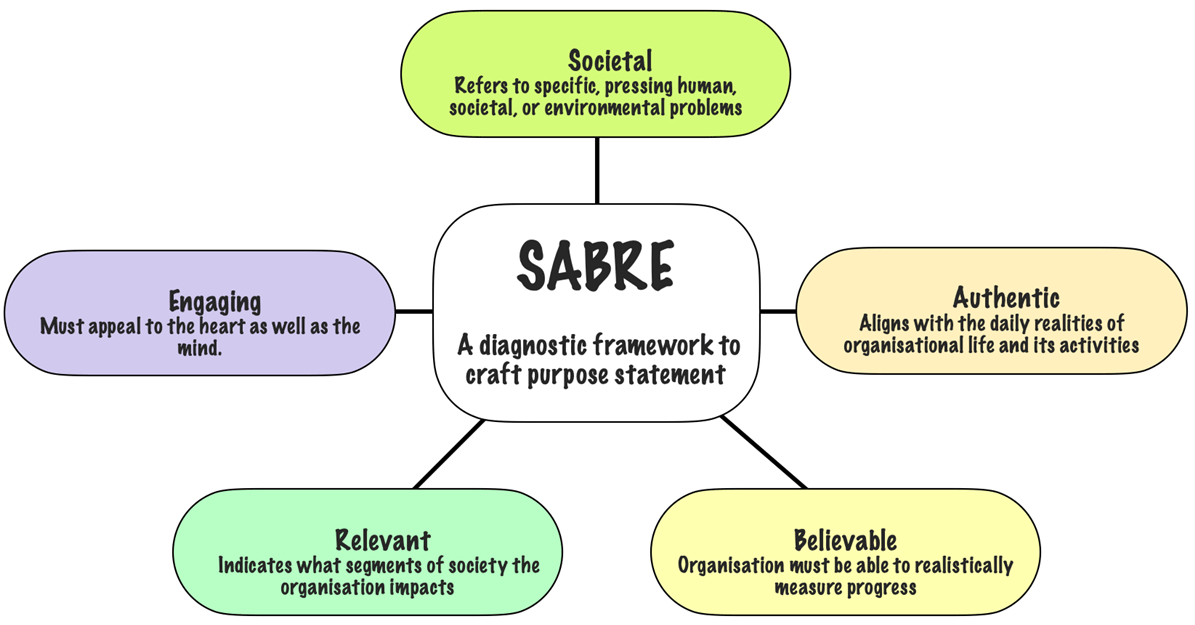
(Source: What Makes a Great Corporate Purpose Statement, Harvard Business Review [9])
Must address a Societal cause
At a foundational level, a purpose statement must address a specific, pressing human, societal, or environmental need that the organization seeks to address or alleviate. However, not all organizations directly address such needs by virtue of their operations.
General-purpose companies, such as Microsoft or Airbnb, do not have a direct social or environmental impact due to their day-to-day operations, whereas social-purpose companies, such as Tesla, prioritize addressing social or environmental issues as a core mission alongside profitability.
Purpose statement for general-purpose organizations
Regardless of their type, an organization can still incorporate elements of societal impact into its purpose statement.
For example, Microsoft defines its purpose as “to empower every person and organization on the planet to achieve more” [10] which goes to show that even when a company is not directly involved in a societal cause, its purpose can still include elements of societal aspects.
Microsoft’s purpose can manifest itself in both ways, general purpose (its cloud computing business) as well as social purpose (X-Box adaptive controller for disabled kids, Office accessibility tools, AI for the visually impaired etc.).
Similarly, Airbnb’s purpose statement – ‘create a world where anyone can belong anywhere’ [11] is both grounded in everyday experience and stretches to an incredibly ambitious goal that seeks to break down barriers caused by cultural, geographical, and racial differences.
Airbnb went a step further to introduce the “Open Homes” program [12] which has helped countless people with temporary housing in times of natural calamities and crisis – a classic example of a social purpose manifestation.
Purpose statement for social-purpose organizations
It is easier to include the societal element in the purpose statement of companies that have a social purpose built into their core operations.
Tesla is a classic example. Its purpose statement is simple yet very powerful – “Accelerating the world’s transition to sustainable energy” [13].
This conveys huge environmental ambition and directly relates to what Tesla does – develop products that are not only sustainable but far superior to fossil-fuel alternatives, which might one day put an end to the era of fossil-fuel transport on the planet.
Must be Authentic
Stakeholders, both internal and external, look for companies in which they can place their trust. An organization’s stated purpose must accurately and honestly reflect its true aims. Otherwise, it can erode confidence and credibility in the eyes of these stakeholders.
ExxonMobil, for example, states its purpose as “Fueling the world safely and responsibly” [14]. However, the company downplayed the adverse impact of climate change for decades despite the knowledge of its causes and dangers since the 70s [15] [16].
Exxon has since been one of the prime targets of activists and politicians angered by the oil industry’s efforts to block action on climate change. Similarly, Philip Morris International’s purpose statement (which it changed in 2016) is “to deliver a smoke-free future”, but in 2022 alone, it shipped over 621 billion cigarettes [17].
Authenticity is also crucial to maintaining employee motivation and engagement. When employees perceive a mismatch between the stated purpose and the daily realities of organizational life, it can lead to disenchantment and, ultimately, the decision to quit.
For example, Volkswagen’s values include “sustainability and community: for the future. for everyone” [18]. However, when the group was hit by the Dieselgate emission scandal, its employee satisfaction took a significant hit.
Before the scandal broke, VW was rated the best in almost every dimension of workplace satisfaction when compared to peers such as BMW, Mercedes, and its own subsidiary, Audi.
When news of its emissions testing misconduct emerged, those positive numbers tanked, and VW was rated worst in 12 out of 13 dimensions of an employment survey [19].
Leaders can identify gaps between a company’s stated purpose and its actual direction by including questions related to the purpose statement in regular employee surveys.
Companies that misrepresent themself in their purpose statement also end up disappointing customers and investors which can give rise to accusations of purpose-washing, dilute brand value and damage reputation [20].
Must be Believable
A good purpose statement must be believable in the sense that it must be within the power of the organization to allocate resources and assess progress towards fulfilling that purpose.
Statements that are too grandiose, such as a small NGO claiming to “eliminate hunger in the world” or vague statements such as “to help make the world better” often fail the believability test and end up being uninspiring. Stakeholders then end up asking “But how?”.
For example, AT&T’s statement – “Connecting people to greater possibility – with expertise, simplicity, and inspiration” [21] scores high on the believability dimension as it aligns perfectly with AT&T’s operations in wireless communication and is well within the means of its resources.
Must be relevant to Beneficiaries
A clear purpose statement can not only clarify but also inspire desired behaviors toward its beneficiaries. But to do that, it must clearly indicate who the beneficiaries are – the segment of society (or the environment) it intends to benefit.
In a 2020 survey by PwC that covered over 2,000 CEOs, more than half the respondents (51%) failed to mention any beneficiaries (the who) in their purpose statements [22].
Statements that fail to mention beneficiaries remain all but abstract.
For example, statements such as “to improve profit, sustainable growth, and long-term stability” and “improve health and well-being” could potentially create confusion as to whose health are we talking about — is it customers, employees, the public, or another group?
A good way to avoid this is to put the beneficiaries at the forefront of the statement and reference how the organization benefits them.
For example, S&P Global’s purpose statement – “We accelerate progress in the world by providing intelligence that is essential for companies, governments and individuals to make decisions with conviction” clearly communicates the role of S&P along with the section of stakeholders it intends to serve [23].
Must be Engaging
This is the dimension of a purpose statement that lays emphasis on how it is worded.
Great purpose statements are engaging and inspiring and appeal to the heart as much as to the mind. They are crisp, impactful, and leave a lasting impression on memory. In contrast, when statements are too long, they become unclear and lose their grip on people’s attention.
For example, compare Mastercard’s:
“We work to connect and power an inclusive digital economy that benefits everyone, everywhere by making transactions safe, simple, smart and accessible, Connecting everyone to Priceless possibilities” [24]
with that of Bank of America’s:
“To help make financial lives better through the power of every connection.” [25]
While Mastercard’s statement is detailed and lays emphasis on inclusivity, safety, and accessibility, it is also lengthy and less likely to be remembered. In contrast, Bank of America’s purpose statement is concise, powerfully conveys its intent, and leaves its mark in the memory.
While there are no definite guidelines as to how a purpose statement must be worded, the following guidelines come in handy:
- A purpose statement must be inspiring – It must be aspirational, inspirational, and even poetic and must reveal the “engine” that keeps a company running.
- Must be as short and sweet as possible to aid memorability. (For example, Google’s short yet powerful – “To organize the world’s information”)
- Must have an outcome (For example, Barbie’s “To inspire the limitless potential in every girl”)
- Must create tension – a great purpose statement must unite conflicting intentions that create a space for continuous innovation and growth.
For example, IKEA’s “To create a better everyday life for the many people” [26] conveys the company’s goal to make durable, sustainably made furniture (which can be expensive) but at the lowest possible cost. - Must strike a balance between aspiration and precision. It must be aspirational but not vague, precise but not limiting and must leave room for a company to grow.
For example, Lego’s “To inspire and develop the builders of tomorrow” [27] - It should be systemic and rational but also emotional; it should resonate with members of the organization and inform their decision-making.
A purpose statement can evolve with time
Companies are not static. There are many examples of successful companies that reinvented their business. Samsung started as a company trading dried fish and groceries while Nokia started as a pulp mill.
As a company grows or the context around it changes, its purpose may need to be reframed.
For example, Tesla changed its purpose statement from “we exist to accelerate the planet’s transition to sustainable transport” to “we exist to accelerate the planet’s transition to sustainable energy.”
Tesla’s offerings today expand beyond cars into products such as solar roofs, power-wall batteries that power homes during outages, and megapacks that stabilize renewable energy electric grids during peak power demand.
Additionally, with the shift towards stakeholder capitalism, companies are forced to redefine what success looks like and how to achieve it. With the change in the traditional mindset of maximizing value for shareholders to maximizing it for all stakeholders, companies are increasingly finding their very purpose questioned.
For example, British Petroleum (BP) has been an energy company involved in extractive industries since its founding. In 2020, BP changed its purpose to reflect its commitment to become a net-zero carbon emitter. Its purpose statement changed from “Making energy more” to “reimagining energy for people and planet” [28].
Delivering value with purpose: The 5P framework
Companies that live by their purpose radiate authenticity and do well by doing good. Leaders allocate capital and resources with purpose in mind while employees use purpose as a guiding star for decision-making. Customers, suppliers, partners, and investors in such companies recognize their value proposition.
But developing such dynamics can be hard. It requires leaders to embed purpose throughout the organization.
McKinsey & Company has proposed a five-step framework that companies can use to make purpose real, steer clear of potential vulnerabilities, and help unlock meaningful value [29]:
Called the 5Ps framework, it consists of five critical elements:
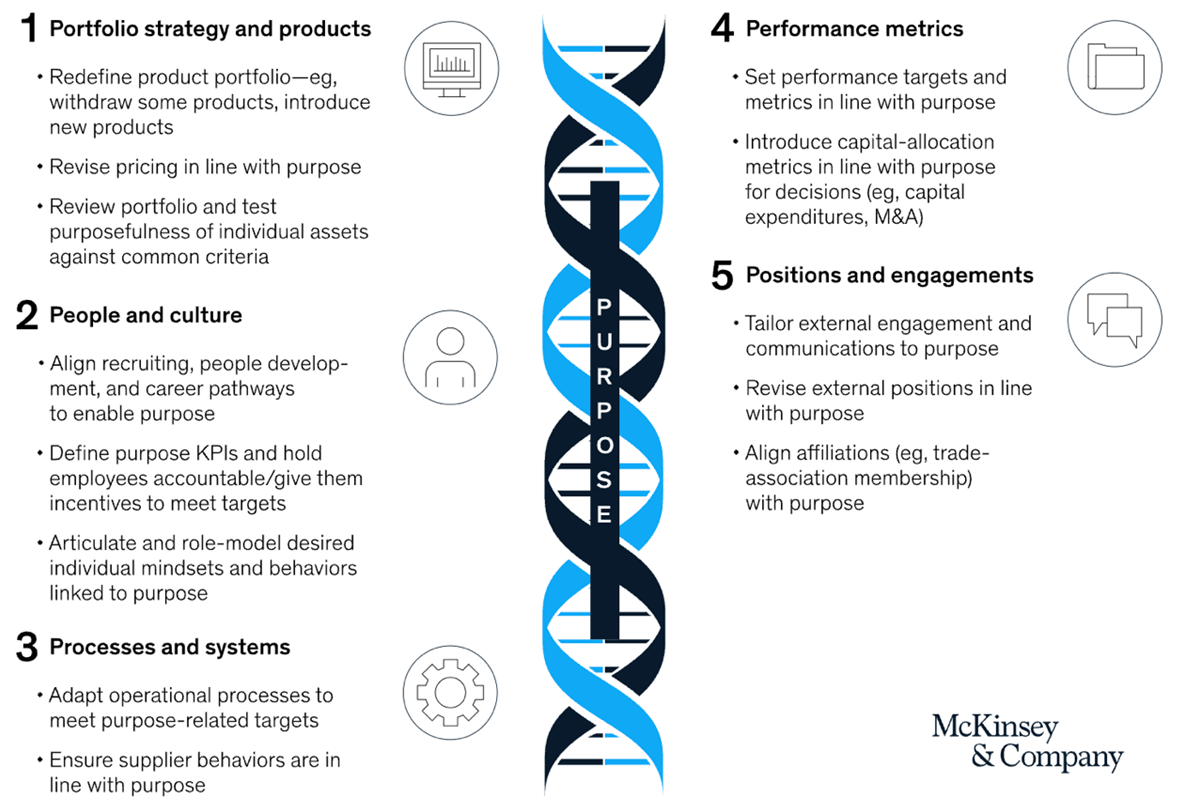
1. Portfolio strategy and products
Demonstrating purpose in the products and services requires a two-step process. First, the business portfolio must align with the company’s purpose. Second, a company must fill out its businesses with products and services that match its chosen portfolio and winnow out those that don’t.
While most companies will not have the choice of starting from a clean slate in terms of the industries and sectors, almost all can identify ways to reshape their business mix in an active, purposeful way.
For example, BP has reimagined what an energy company can be. It not only exited its petrochemicals businesses but also announced plans to shrink its legacy oil & gas businesses by 40% by 2030.
BP is on the path to scale up its low-carbon energy businesses such as bioenergy, hydrogen, and electric-vehicle charging, and to put itself on a path to become a net-zero carbon emitter by 2050 or sooner [30].
Google’s parent company, Alphabet prioritizes “freedom and focus” and in line with it, google restricts Play Store apps that promote gambling and those that offer personal loans with excessive annual percentage rates.
Likewise, toy companies are genuinely embracing diversity, equity and inclusion by learning and collaborating with identity-based communities to improve products. Mattel, the company that manufactures Barbie now offers dolls in a wide variety of body sizes, skin tones, hair textures, and ability status [31].
2. People and culture
As every purpose is about human beings, a company’s employees and its stakeholders serve as sources of strength and a hard check against inauthenticity. An organization’s purpose must align at critical points with its people and culture.
This process starts with hiring. As changing people can be hard, managers must actively screen for individuals who share values that align with the company’s purpose. Human resource decisions must be grounded in purpose and must drive people’s development and career pathways.
Mindsets and behaviors linked to company purpose must be well-articulated and “role-modeled”. Aligning with purpose is not about management saying some nice words and calling it a day. Unless it is reflected in key performance indicators (KPI), benefits are limited.
People want purpose and meaning from their work. Organizations that can genuinely satisfy this need are the ones with the most engaged employees. Passionate employees radiate enthusiasm to customers and communities alike.
Studies have shown that organizations with engaged employees achieve earnings-per-share growth that is more than four times that of their competitors [32].
3. Processes and systems
This element addresses the “how” of the business model: the operational initiatives and governance mechanisms that an organization depends upon to realize its purpose.
While some aspects of these elements are dictated by regulations and industry standards, an organization must go beyond to be the best and set an example. Embedding purpose into a company’s processes and systems requires looking beyond a firm’s four walls.
For example, Patagonia, whose purpose is “to save our home planet”, does not stop at being carbon-neutral in its own processes. Acknowledging that the bulk of its emissions (95%) comes from its supply chain and materials manufacturing, Patagonia has stood up and taken responsibility for all of it.
It holds itself accountable by setting ambitious goals across the company and its network of partners in alignment with a set of standards based on its Science Based Target Initiative (SBTi) [33].
4. Performance metrics
As only that which gets measured gets managed, it is crucial to measure purpose. This means identifying the KPIs attached to a company’s purpose, tracking them over time, and incenting employees to meet purpose targets.
Since purpose expresses what a company stands for and aspires to be, purpose metrics should extend beyond the day-to-day operations to include allocation decisions such as capital expenditures and M&A, as well as company-wide transformation initiatives.
Organizations are increasingly adopting such practices. For example, a global study that looked at the prevalence of ESG-linked pay for executives found that 38% of the listed firms followed the practice in 2021 compared to just 1% in 2011 [34].
Companies can use a range of KPIs and tools but, because every purpose is unique to an organization, off-the-shelf solutions are seldom as effective as the ones that are carefully tailored.
Companies can also go beyond monetary incentives to encourage community outreach by celebrating offices and employees who contribute measurably to the organization’s mission. Behavioral economics principles can be used to “nudge” for positive behavior, such as energy saving or waste reduction.
Sometimes, simply showing employees and other stakeholders how the organization is progressing along metrics such as diversity or sustainability reinforces the purpose and helps build momentum for more.
5. Positions and communication
A company’s purpose must be hardwired into its positions, communications, and external engagement. Artificial expressions of purpose ring false, and stakeholders recognize inauthenticity.
Sadly, In the rush to stand for something, organizations have risked putting the purpose ‘story’ ahead of the purpose plan and actions. When ‘purpose promise’ does not match the ‘purpose experience’, organizations face a real risk of reputational damage.
For example, when McDonald’s launched ‘McPlant’, its meat-free burger, critics were quick to point out McDonald’s inaction on sustainability issues and the lack of a clear link between the launch of ‘McPlant’ and its current sustainability plan.
McDonald’s has been years behind competitors like White Castle and Burger King in fully introducing plant-based burger options [35].
Purpose-washing: The dangers and how to avoid it
Companies today are in a rush to match their core purpose with the values of society, such as inclusion, fairness, and respect and have become more outspoken about environmental and social issues.
Customers, employees, investors, and communities are increasingly expecting businesses to express a clear and public position on issues that matter to them.
Unfortunately, such highly visible pledges of purpose commitment have, paradoxically, also resulted in public concern and backlash. 56% of people now believe that purpose-driven marketing is a way for firms to promote their goods, rather than a real commitment to solve social or environmental problems [36].
What is purpose-washing
When an organization’s purpose statement is communicated to external stakeholders, a lack of perceived authenticity can easily escalate into accusations of purpose-washing – a term that combines the concepts of greenwashing and woke-washing.
Greenwashing refers to companies portraying themselves as environmentally conscious even though their actions do not align with their claims. Woke-washing is an accusation that arises when companies claim to care about socio-political issues, but stakeholders believe they do not.
In both cases, claims that are based on a broader purpose that goes beyond economic profit maximization are not perceived as consistent with actions.
Examples of companies accused of purpose-washing
The below table gives an overview of companies in different industries that have faced accusations of purpose-washing for varied reasons:
| Company | Industry | Basis of criticism | Accusation of purpose-washing |
|---|---|---|---|
| L’Oréal Paris, | Cosmetics | Diversity and inclusion | Munroe Bergdorf, a transgender model, was hired by L’Oréal to represent its diversity initiative; however, upon speaking out against racism in the workplace, her contract was immediately terminated. This move seemed to go against L’Oréal’s stated commitment to diversity [37]. |
| H&M | Fashion | Racially insensitive | H&M’s stated purpose is to promote diversity and inclusion. It received accusations of racial insensitivity due to a black boy modeling in a hoodie bearing the inscription ‘the coolest monkey in the jungle’. Another instance involved a young black model with poorly maintained hair, which was perceived to be supporting a negative stereotype [38]. |
| Volkswagen | Automobile | Environmental damage and deception | VW’s stated purpose was to deliver sustainable cars for a better future. The company was accused of tampering with emissions testing, which resulted in the ‘Dieselgate’ scandal and major financial losses [39]. |
| Nike | Sportswear | Ingenuine about racial injustice | The purpose of Nike’s ‘For Once, Don’t Do it’ campaign, which was launched during the height of the Black Lives Matter Movement, was to promote racial equality. The accusation claimed that Nike was ingenuine and simply jumping on the bandwagon due to the popularity of the issue [42]. |
| Audi | Automobile | Gender inequality | The stated purpose of Audi’s advertising campaign was to advocate for women’s empowerment. The accusation was that the company lacked female representation at the executive level [43]. |
| M&M’s | Food and beverages | Gender inequality | M&M’s purpose was to have a gender balance within the iconic chocolate mascots. The accusation involved changing the female mascot’s shoes from high heels to sneakers, which was perceived by critical consumers to be an indication that the organization missed the point of feminism and just wanted to exhibit a ‘progressive’ image [44]. |
Source: Purpose-washing: What it is, and how to avoid it, King’s Business School [36]
Numerous companies across industries have come under fire for misalignment between their stated purposes and actual behavior for a variety of reasons and to different degrees.
Staying clear of purpose-washing
In addition to the obvious ethical concerns, negative consequences of purpose-washing include a decrease in trust, damaged reputation, and substantive financial losses. When organizations take a public stance based on their purpose, they join a broader public conversation on the topic.
According to research by Paul A. Argenti, professor of corporate communication at Dartmouth College’s Tuck School of Business [45], there are three considerations that managers must bear in mind when they speak in public or take a stand on matters related to their purpose:
Does the issue align with the organization’s strategy?
An organization’s strategy is based in part on the company’s mission and values. If there is a misalignment with the issue being spoken out on, such statements will be viewed as inauthentic.
Can the organization meaningfully influence the issue?
If the organization does not have the expertise and resources to make a difference or is not willing to commit financial resources towards the cause, then the organization risks being seen as hypocritical or being accused of “woke-washing.”
Will the constituencies agree with speaking out?
Every organization works with constituencies – distinct groups or entities that have a stake or interest in the organization’s decisions and actions. (e.g., customers, investors, employees, etc.).
If the key constituencies agree with the position taken by the organization, then the risk of disrupting future business is greatly reduced. However, when these constituencies disagree, it becomes crucial to discuss and carefully weigh the position based on relative importance to business.
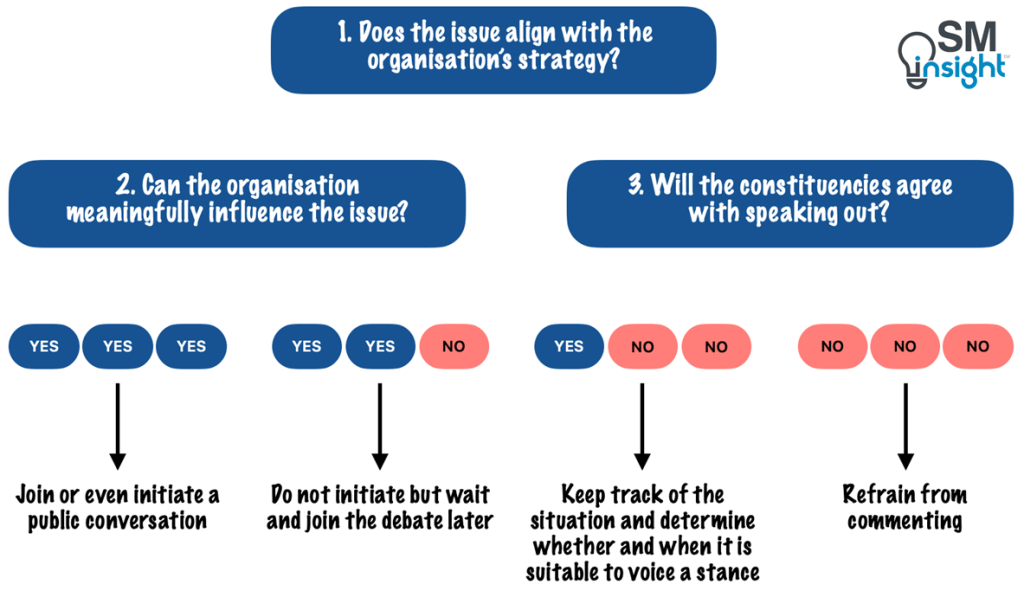
If a company meets all the above conditions, it can join or even initiate a public conversation around its purpose without the risk of being accused of purpose-washing. However, if only two of the conditions are met, it is better to wait and join the debate later rather than acting as a conversation starter.
When just one condition is met, it is critical to keep track of the situation and determine
whether and when it is suitable to voice a stance. If none of the conditions are met, the company should refrain from commenting on the matter.
Initiating effective purpose-driven campaigns
Once an organization decides to take a public stance, three guiding principles are important.
First, it must carefully consider how to communicate its commitment in a meaningful manner. It is insufficient to merely issue campaigns and merchandise relating to their purpose as the perception of authenticity relies strongly on stakeholders correctly interpreting the alignment of the stated purpose with the company’s practice.
Second, the stance must be unambiguous. Research indicates that staying neutral and thus not taking a clear stance, can lead to a lack of perceived authenticity [46]. While striving for fair representation is vital, it is also critical that a company’s stance is clear, well-thought-out and displays a real commitment to its principles.
Finally, the message must be consistent for it enhances authenticity.
Thus, purpose can be a source of powerful competitive advantage, but only when it is genuine and infused into an organization’s business model.
Read also: Mission Statement
Sources
1. “The Power Of Purpose: The 7 Elements Of A Great Purpose Statement (Part 1)”. Forbes, https://www.forbes.com/sites/afdhelaziz/2020/02/18/the-power-of-purpose-the-7-elements-of-a-great-purpose-statement/?sh=1470a4473fad. Accessed 08 Apr 2024.
2. “People on a mission”. Korn Ferry Institute, https://www.kornferry.com/content/dam/kornferry/docs/article-migration/Korn_Ferry_People_on_a_Mission_1219.pdf. Accessed 08 Apr 2024.
3. “The 20 employers engineering students most want to work for”. Business Insider, https://www.businessinsider.in/policy/economy/news/the-20-employers-engineering-students-most-want-to-work-for/slidelist/93758602.cms. Accessed 08 Apr 2024.
4. “The search for purpose at work”. McKinsey & Company, https://www.mckinsey.com/capabilities/people-and-organizational-performance/our-insights/the-search-for-purpose-at-work. Accessed 08 Apr 2024.
5. “Putting Purpose to Work: A study of purpose in the workplace”. PwC, https://www.pwc.com/us/en/purpose-workplace-study.html. Accessed 08 Apr 2024.
6. “Our Purpose”. Kroger, https://www.thekrogerco.com/about-kroger/. Accessed 08 Apr 2024.
7. “General Information about Intel Corporation: What Are Intel’s Purpose, Commitments, Values, Vision, and Brand?”. Intel, https://www.intel.com/content/www/us/en/support/articles/000015119/programs.html. Accessed 08 Apr 2024.
8. “About us”. Decathlon, https://sustainability.decathlon.com/about-decathlon. Accessed 08 Apr 2024.
9. “What Makes a Great Corporate Purpose Statement”. Harvard Business Review, https://hbr.org/2023/09/what-makes-a-great-corporate-purpose-statement. Accessed 07 Apr 2024.
10. “What we value”. Microsoft, https://www.microsoft.com/en-us/about/values. Accessed 07 Apr 2024.
11. “Airbnb 2019 Business Update”. Airbnb, https://news.airbnb.com/airbnb-2019-business-update/. Accessed 07 Apr 2024.
12. “Airbnb’s Open Homes platform hopes to house 100,000 displaced people”. The Spaces, https://thespaces.com/airbnbs-open-homes-platform-hopes-to-house-100000-displaced-people/. Accessed 07 Apr 2024.
13. “About”. Tesla, https://www.tesla.com/about. Accessed 07 Apr 2024.
14. “Who we are”. Exxon Mobil, https://corporate.exxonmobil.com/who-we-are. Accessed 07 Apr 2024.
15. “Exxon’s Climate Denial History: A Timeline”. Greenpeace, https://www.greenpeace.org/usa/fighting-climate-chaos/exxon-and-the-oil-industry-knew-about-climate-crisis/exxons-climate-denial-history-a-timeline/. Accessed 07 Apr 2024.
16. “ExxonMobil loses bid to nix climate change lawsuit”. The Associated Press, https://apnews.com/article/climate-environment-darren-woods-lawsuits-9650332ea94d2ee22eb415e80b142134. Accessed 07 Apr 2024.
17. “Is PMI Really Creating a ‘Smoke-Free Future’?”. Exposetobacco.org, https://exposetobacco.org/news/pmi-smoke-free-future/. Accessed 08 Apr 2024.
18. “Our Values and Actions”. Volkswagen, https://www.vw.com/en/our-values-and-actions.html. Accessed 08 Apr 2024.
19. “How Volkswagen Rallied Its Employees After Its Emissions Scandal (At Least For Now)”. Forbes, https://www.forbes.com/sites/karstenstrauss/2017/07/26/how-volkswagen-rallied-its-employees-after-its-emissions-scandal-at-least-for-now/. Accessed 07 Apr 2024.
20. “The Evolution Of Purpose Wash And How To Avoid It”. CEO Today, https://www.ceotodaymagazine.com/2020/12/the-evolution-of-purpose-wash-and-how-to-avoid-it/. Accessed 07 Apr 2024.
21. “Our Purpose”. AT&T, https://about.att.com/pages/corporate-profile. Accessed 07 Apr 2024.
22. “Why corporate purpose statements often miss their mark”. PwC, https://www.strategy-business.com/article/Why-corporate-purpose-statements-often-miss-their-mark. Accessed 08 Apr 2024.
23. “We are S&P Global.”. S&P Global, https://www.spglobal.com/en/who-we-are/. Accessed 08 Apr 2024.
24. “About Mastercard”. Mastercard, https://www.mastercard.us/en-us/vision/who-we-are.html. Accessed 08 Apr 2024.
25. “Our company”. Bank of America, https://about.bankofamerica.com/en/our-company. Accessed 08 Apr 2024.
26. “The IKEA vision and values”. IKEA, https://www.ikea.com/gb/en/this-is-ikea/about-us/the-ikea-vision-and-values-pub9aa779d0. Accessed 08 Apr 2024.
27. “Purpose”. Kirkbi, https://www.kirkbi.com/about/purpose/. Accessed 08 Apr 2024.
28. “Presentation – Bernard Looney”. BP, https://www.bp.com/content/dam/bp/business-sites/en/global/corporate/pdfs/investors/2q-strategy-2020-bernard-looney-strategy-overview.pdf. Accessed 08 Apr 2024.
29. “More than a mission statement: How the 5Ps embed purpose to deliver value”. McKinsey & Company, https://www.mckinsey.com/capabilities/strategy-and-corporate-finance/our-insights/more-than-a-mission-statement-how-the-5ps-embed-purpose-to-deliver-value. Accessed 08 Apr 2024.
30. “Insight: Inside BP’s plan to reset renewables as oil and gas boom”. Reuters, https://www.reuters.com/business/sustainable-business/inside-bps-plan-reset-renewables-oil-gas-boom-2023-03-07/. Accessed 08 Apr 2024.
31. “She’s a Barbie girl, in a new world”. Mashable, https://mashable.com/feature/barbie-diverse-inclusive. Accessed 08 Apr 2024.
32. “The Power Of Purpose: The Business Case For Purpose (All The Data You Were Looking For Pt 2)”. Forbes, https://www.forbes.com/sites/afdhelaziz/2020/03/07/the-power-of-purpose-the-business-case-for-purpose-all-the-data-you-were-looking-for-pt-2/. Accessed 08 Apr 2024.
33. “The Climate Crisis Is Our Business”. Patagonia, https://www.patagonia.com/climate-goals/. Accessed 08 Apr 2024.
34. “Executive Compensation Tied to ESG Performance: International Evidence”. SHIRA COHEN, IGOR KADACH, GAIZKA ORMAZABAL, STEFAN REICHELSTEIN, https://onlinelibrary.wiley.com/doi/full/10.1111/1475-679X.12481. Accessed 08 Apr 2024.
35. “Hold the beef: McDonald’s avoids the bold step it must take to cut emissions”. Guardian, https://www.theguardian.com/environment/2021/dec/10/mcdonalds-emissions-beef-burgers. Accessed 08 Apr 2024.
36. “Purpose-washing: What it is, and how to avoid it”. KING’S BUSINESS SCHOOL, https://www.kcl.ac.uk/business/assets/research/literature-review-purpose-washing.pdf. Accessed 08 Apr 2024.
37. “Munroe Bergdorf accuses L’Oréal of racial hypocrisy”. The Guardian, https://www.theguardian.com/fashion/2020/jun/02/munroe-bergdorf-accuses-loreal-of-racial-hypocrisy. Accessed 07 Apr 2024.
38. “H&M Apologizes for ‘Monkey’ Image Featuring Black Child”. The New York Times, https://www.nytimes.com/2018/01/08/business/hm-monkey.html. Accessed 06 Apr 2024.
39. “What Was the Dieselgate Scandal?”. International Environmental Technology, https://www.envirotech-online.com/news/air-monitoring/6/international-environmental-technology/what-was-the-dieselgate-scandal/59471. Accessed 06 Apr 2024.
40. “This article is more than 5 years old Stonewall and Primark criticised for Pride T-shirts made in Turkey”. The Guardian, https://www.theguardian.com/world/2018/aug/02/stonewall-and-primark-criticised-pride-t-shirts-made-in-turkey-lgbt-rights. Accessed 08 Apr 2024.
41. “The Starbucks Anti-Pride Controversy, Explained”. Bon Appetit, https://www.bonappetit.com/story/starbucks-anti-pride-controversy. Accessed 08 Apr 2024.
42. “6 months later: Activist marketing takeaways from Nike, Ben & Jerry’s calls for racial justice”. Marketing Dive, https://www.marketingdive.com/news/6-months-later-activist-marketing-takeaways-from-nike-ben-jerrys/591421/. Accessed 08 Apr 2024.
43. “Why Audi’s Super Bowl Ad Failed”. Forbes, https://www.forbes.com/sites/jeffkauflin/2017/02/06/why-audis-super-bowl-ad-failed/. Accessed 08 Apr 2024.
44. “How M&M’s Became the Latest Flash Point in the Culture Wars”. Time, https://time.com/6249551/m-m-candy-mascots-culture-wars/. Accessed 08 Apr 2024.
45. “When Should Your Company Speak Up About a Social Issue?”. Harvard Business Review, https://hbr.org/2020/10/when-should-your-company-speak-up-about-a-social-issue. Accessed 08 Apr 2024.
46. “Woke brand activism authenticity or the lack of it”. Abas Mirzaei, Dean Wilkie and Helen Siuki , https://www.researchgate.net/publication/355082665_Woke_brand_activism_authenticity_or_the_lack_of_it. Accessed 07 Apr 2024.
47. “Your Corporate Purpose Changed. Has Your Strategy Kept Up?”. Harvard Business Review, https://hbr.org/2022/07/your-corporate-purpose-changed-has-your-strategy-kept-up. Accessed 07 Apr 2024.

